Aglaonema Care: How to Grow Chinese Evergreen
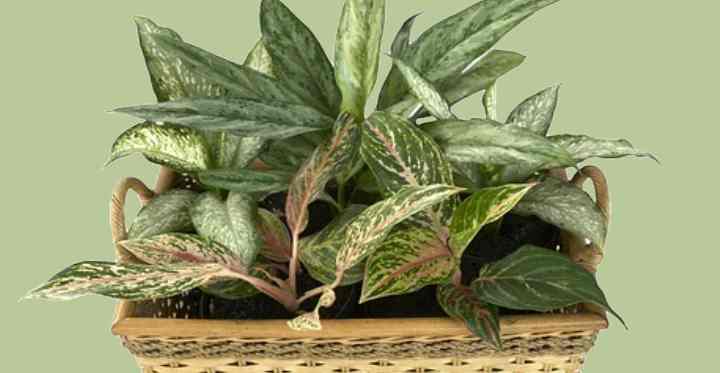
Chinese evergreen plants (Aglaonema) are a group of flowering tropical plants with beautifully patterned leaves. Aglaonema plants are straightforward to grow at home, where their bright foliage brings color in shaded rooms. Some species of Chinese evergreens have pink, silver, red, yellow, or orange patterns on glossy green leaves. These tropical plants occasionally bloom indoors with spathe type flowers similar to other types of aroids such as such as anthurium plants.
How to care for Aglaonema plants: Chinese evergreens thrive in bright to low light, growing in moist potting soil, and medium to high humidity. Only water the houseplant when the top 1” (2.5 cm) of soil is dry. Keep temperatures between 65°F and 80°F (18°C – 26°C), and fertilize monthly during the growing season.
Aglaonema houseplants are classified in the plant family Araceae. Depending on the species, these plants—native to Asia—grow erect or low, creeping stems. In tropical and subtropical rainforests, Chinese evergreens grow slowly, and they love shaded conditions. Growing in pots indoors, mature Aglaonema plants grow to between 1 and 4 ft. (30 – 120 cm).
Many people keep Chinese evergreen plants as ornamental houseplants. For example, the ‘Silver Queen’ cultivar has long, 12-inch (30-cm) leaves and a silvery-green appearance.
Under ideal conditions, Aglaonema plants flower indoors, and the blooms can last for a few months. However, it’s the showy, colorful foliage that makes these plants desirable indoor plants.
Types of Aglaonema (Chinese Evergreen)
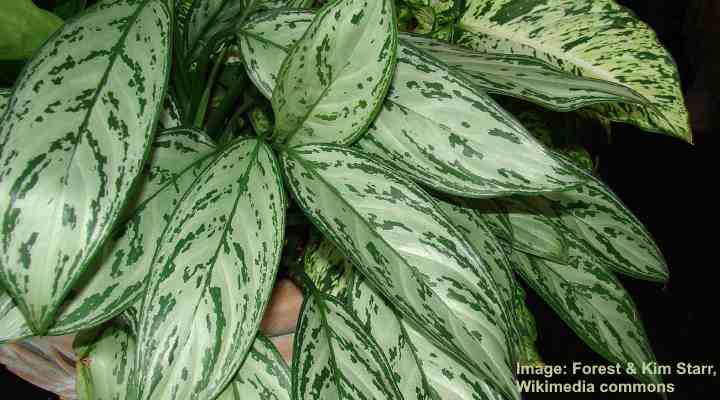
Aglaonema commutatum ‘Silver Queen’ is the most popular cultivar of aglaonema houseplant
Aglaonema plants include many cultivars grown mainly for the patterns and colors of the leaves. For example:
- Aglaonema ‘Silver Queen’—Also called the ‘painted drop tongue,’ this species has attractive silver-gray and green variegated leaves.
- Aglaonema ‘White Calcite’—A houseplant with striking foliage consisting of lance-shaped green leaves with bright white markings.
- Aglaonema ‘Siam Aurora’—The foliage on this red Aglaonema is pointed glossy-green leaves with dark red edges and veins.
- Aglaonema ‘Anyanmanee’—Another species of red Aglaonema, but this one has dusty pink and green variegated leaves.
- Aglaonema ‘Pink Dalmatian’—The dark green leaves of this Chinese evergreen cultivar have delicate pink spots and speckles.
- Aglaonema ‘Red Emerald’—This stunning houseplant has dark green leaves with prominent red veins and amber markings.
- Aglaonema ‘Silver Bay’—The brightly-colored silvery foliage of this Chinese evergreen will add to the aesthetics of any indoor interior.
Chinese Evergreen Flowers
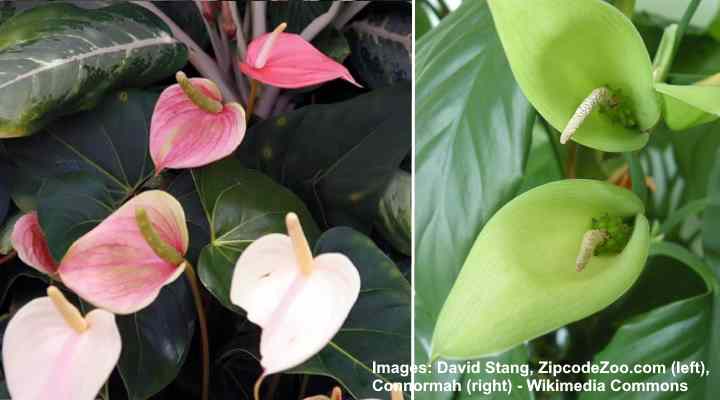
Flowers of Aglaonema varieties
Aglaonema plants produce flowers similar to other aroid plants such as types of anthurium plants. Aglaonemas can flower indoors if conditions are right. The flowers consist of a colored spathe—a kind of modified leaf—and a spadix—a type of flowering spike. The flowers are usually a pale white color or light green.
The Chinese evergreen flowers aren’t showy, and it’s the foliage that makes these plants attractive.
How to Care for Chinese Evergreen (Aglaonema)
Many people consider Aglaonema to be a type of plant that brings good luck. However, there is no luck involved in looking after these plants at home. Chinese evergreens are some of the easiest to care for houseplants.
How Much Light Does Aglaonema Need?
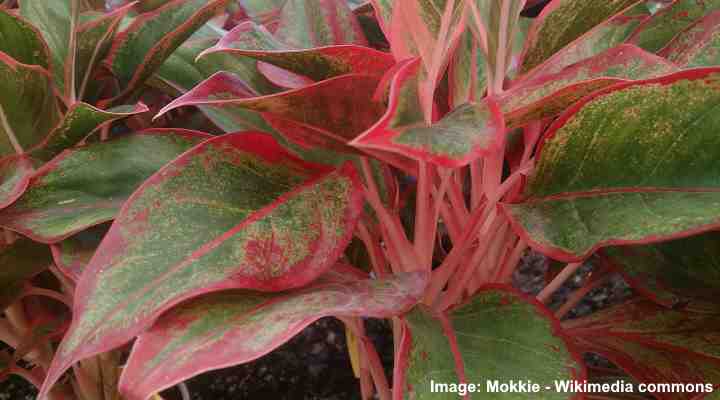
Aglaonema ‘Siam Aurora’ is a plant with beautiful green and red leaves
Chinese evergreen plants thrive in most indoor lighting conditions. Some species of Aglaonema can grow in places where there is virtually no light at all. Other plant cultivars require brighter light to keep their foliage vibrant. The most crucial light requirement is to protect the plant from direct sunlight.
The best types of low-light plants in the Aglaonema genus are the dark-leafed varieties. For example, the ‘Pink Dalmation,’ ‘Red Emerald,’ and ‘Modestum’ all have dark, glossy green leaves. These indoor plants can grow in dark rooms such as bedrooms or poorly-lit bathrooms. However, they will also thrive in brighter locations.
Many of the Aglaonema cultivars that have bright silver, red, or pink foliage need to grow in bright light. Choose a location that gets sunlight in the morning or indirect sunlight in the afternoon and evening. The best species of Chinese evergreens for bright places are ‘Two-Tone Moonstone,’ ‘White Calcite,’ ‘Silver Queen,’ and ‘Golden Fluorite.’
Depending on where you place the potted Chinese evergreen, the location can affect other care needs. For example, in a bright spot, the plant will grow faster and may need frequent watering and regular feeding. However, in a dark location, you will have to water less frequently.
The Best Potting Mix for Chinese Evergreen
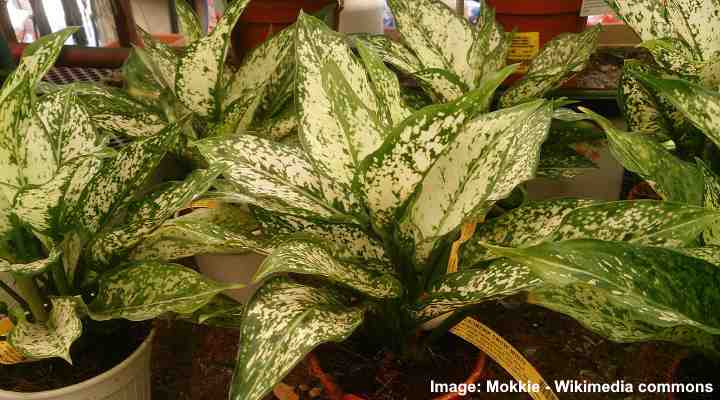
In the picture: Aglaonema ‘Snow White’
Species of Aglaonema grow best in a light, well-draining, slightly acidic potting medium. The loose soil needs to allow excess water to drain quickly to prevent roots from getting soggy and mushy. A suitable potting mix for Chinese evergreens is a peat-based potting soil with perlite to improve drainage.
The ideal type of potting soil for Chinese evergreens should hold just enough moisture to stay slightly moist. Apart from perlite, you can also add pumice or orchid bark to boost drainage. The worst thing that can happen to tropical houseplants is when their roots grow in overly-damp soil.
The best way to tell if you’ve got the appropriate potting soil is by how quickly the water drains. Puddles on the soil surface are a sign that the growing medium is too heavy and dense. Another reason could be that the plant is rootbound. You need to repot the Chinese evergreen in a fresh potting mix that had excellent drainage.
How to Water Chinese Evergreen Indoors
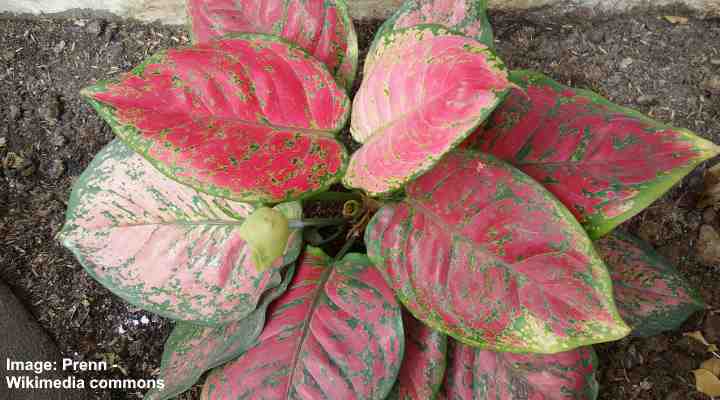
This image shows Aglaonema ‘Valentine’ with its stunning red and green leaves
You should water Aglaonema plants as often as the top part of the soil dries out. The frequency for watering Chinese evergreens depends on the climate, type of soil, and pot. In spring and summer, you’ll have to water the plant more frequently than in fall and winter.
Wait until 1” to 2” (2.5 – 5 cm) of the soil is dry before watering. When it’s time to water the plant, thoroughly soak the soil to hydrate the roots. You should water enough so that excess water drains from the drainage holes. Then, wait until the soil as partly dried again before watering.
One of the common mistakes when it comes to watering houseplants is to water on a set schedule. Watering this way results in overwatering, which causes root rot can end with your plant dying. To know when it’s time to water an Aglaonema plant, poke your finger in the soil. If it’s dry, it is time to drench the soil.
Chinese Evergreen Growth Rate
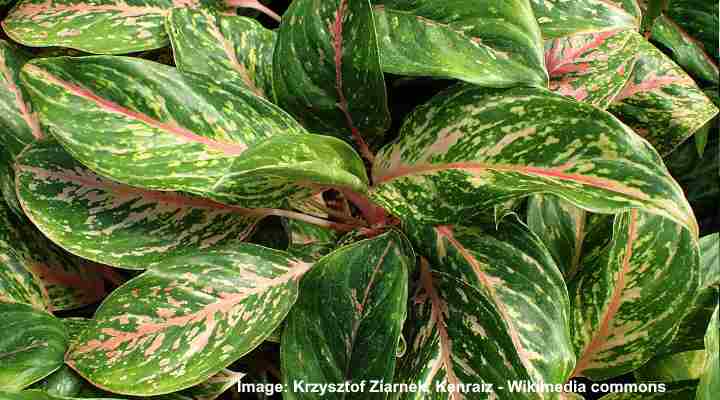
Aglaonema ‘Sparkling Sarah’ has green leaves with specks of pink
Aglaonema plants are typically slow to medium-growing tropical plants. However, some species may have faster growth than others. For example, ‘Silver Bay’ and red ‘Siam Aurora’ plants grow faster than cultivars such as ‘Emerald Beauty.’ Chinese evergreens grow slower in winter and when in low light rooms.
Temperature Requirements for Growing Chinese Evergreen
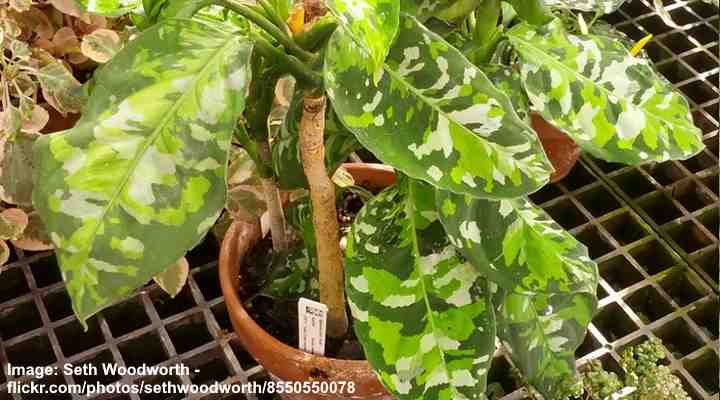
Aglaonema pictum ‘tricolor’ has a very attractive leaf pattern with various shades of green
Aglaonema plants are so easy to grow indoors because they thrive in room temperature. The best temperature for Chinese evergreen is between 65°F and 80° (18°C – 26°C). Aglaonema is intolerant of the cold and will start to die if left below 60°F (15°C). Generally, if you feel comfortable indoors, so will your houseplants.
To successfully grow the tropical houseplants indoors, you should avoid temperature extremes. So, avoid exposing the plant pots to extreme temperatures or sudden fluctuations. In summer, don’t put the plant in cold drafts or air conditioning airflow. In winter, avoid placing your plant near a hot radiator.
You can grow Chinese evergreen outdoors if you have warm temperatures. Aglaonema plants grow in USDA zones 10 and 11. If you live in temperate regions, take your plants outdoors in summer. Find a bright spot on a patio, balcony, or deck that is protected from direct sunshine. Bring the plant indoors when temperatures drop below 65°F (18°C).
Indoor Aglaonema Plants – Humidity
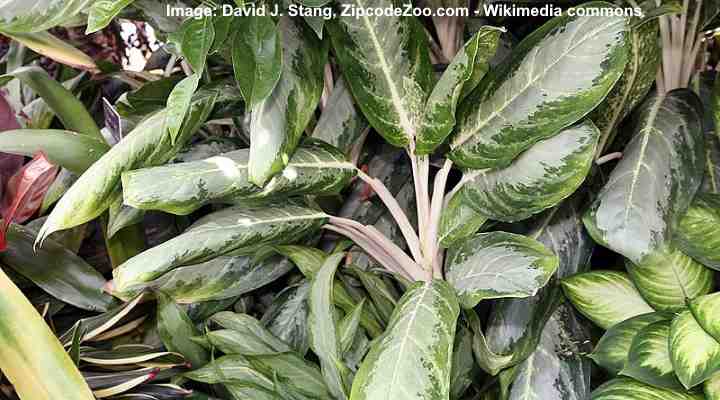
Aglaonema ‘Queen of Siam’
Most species of Chinese evergreens grow well in average humidity. However, to thrive, Aglaonema cultivars prefer high moisture levels in the air—similar to their native tropics. Ideally, they need a humidity level of at least 50%. To meet the humidity needs of these lush, leafy plants, mist them a few times a week, or place on a humidifying tray.
What are the best ways to humidify Chinese evergreen plants? Here are a few ideas:
- Misting—Fill a spray bottle with filtered or distilled water and create a fine mist above the leaves. Avoid spraying jets of water directly onto the leaves.
- Humidifying tray—Increase humidity by placing the plant pot on a humidity tray. You can make this by filling the base of a deep dish with a layer of decorative pebbles. Fill with enough water until it is half-way up the stones. Put the container on the pebbles.
- Humidifier—If you care for many tropical plants indoors, you could use a humidifier to keep humidity at above 50%.
Brown tips on the leaves are one sign that you need to increase humidity. Usually, in winter, you should mist the leaves often and water less frequently. Household heating tends to cause dry air that can make caring for plants indoors challenging.
Growing tip: Because Chinese evergreen plants grow well in dark rooms with high humidity, they are excellent plants for bathrooms.
Fertilizing Chinese Evergreen Plants
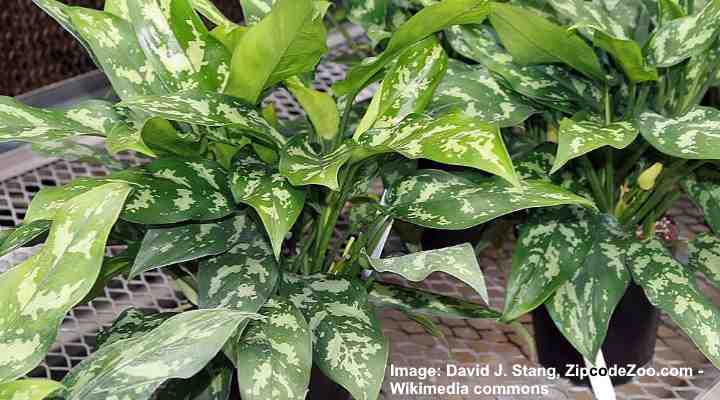
Aglaonema ‘Maria Christina’
Aglaonema plants are slow growers and don’t require a lot of feeding. Usually, a standard houseplant fertilizer diluted at half-strength provides enough minerals and nutrients for healthy growth. You should only fertilize the Chinese evergreen during the growing season once a month, or even less often.
To ensure healthy growth, here are a few things to remember when it comes to feeding:
- Over-fertilizing—Feeding too frequently or with undiluted fertilizer can cause root burn. The buildup of mineral salts can even result in your plant’s growth slowing down. You may also notice that the stems and leaves start drooping.
- Seasonal requirements—Aglaonemas only need fertilizing in spring and summer. Refrain from feeding during the winter months when growth is dormant.
- Soil flush—Once or twice in the growing season, your plant will benefit from soil flushing. Drenching the soil for a few minutes helps to flush out excess minerals that can buildup in the soil.
How to Prune Aglaonema
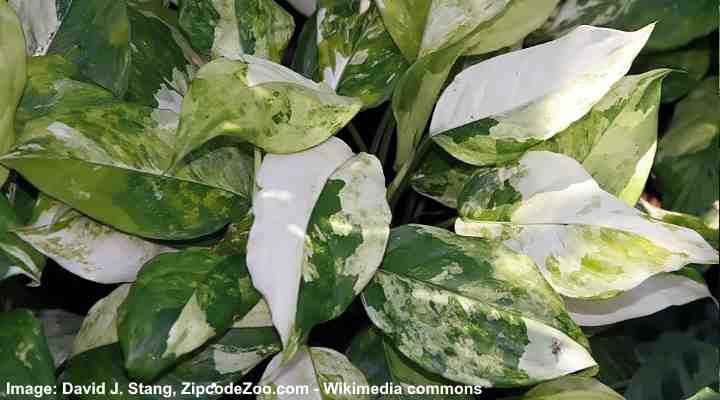
Aglaonema modestum ‘Variegatum’
Trimming a Chinese evergreen can help encourage faster growth, create a bushy houseplant, and remove dead foliage. However, nearly all species of Aglaonema plants have naturally dense growth, so pruning is rarely necessary. Some houseplant experts even advise against pruning the plant because new growth comes from the crown.
If it is necessary to cut back a Chinese evergreen, prune off any dead leaves or leaves that have brown tips. To trim off these leaves, cut the stem near where it grows out the soil.
Another reason for pruning Aglaonema plants is when they flower. If your plant does bloom, it will produce flowers in the spring. But the flowers are inconspicuous and not as attractive as the foliage. Trimming off the flowers helps direct energy to the foliage growth and results in a better-looking plant.
Aglaonema Propagation
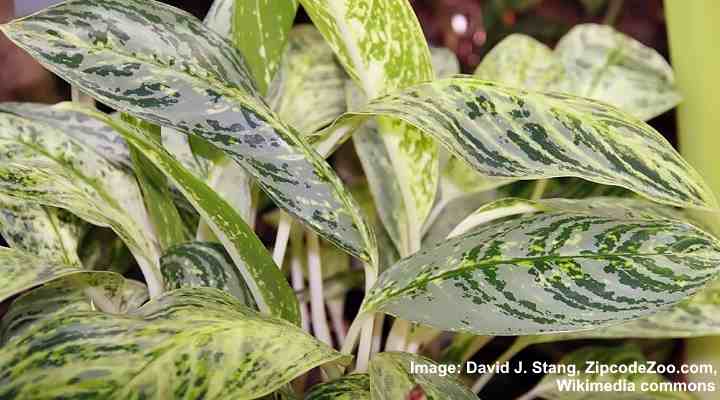
Aglaonema ‘Brilliant’
The best way to propagate Chinese evergreens is by root division. The best time to divide the roots is when you repot the plant every other spring. All you have to do is to split a part of the root that has a few healthy stalks on it. Plant the new plant in a small pot with the appropriate type of potting mix.
How to Repot Chinese Evergreen Plants
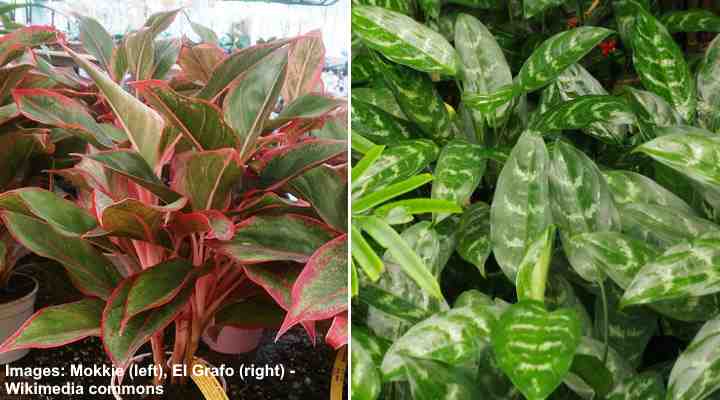
Aglaonema ‘Siam Aurora’ (left) and Aglaonema marantifolium (right)
Due to their medium to slow growth, you may only have to repot Aglaonema cultivars every second year. The best time to transfer to a new pot is in the spring when growth is vigorous. Repotting Chinese evergreens also gives you a chance to check for root rot and refresh the soil.
Replanting in a new pot also encourages healthier growth. As the roots grow, they take up more room in the container. Choosing a new pot one or two sizes up gives the roots more room to grow and helps the plant grow taller. If you want to limit plant growth, you can snip off about one-third of the roots while repotting.
Here are the steps to repot species of Aglaonema:
- Gently remove the plant and the root ball from its existing container.
- Remove all dirt from the roots and untangle them if necessary.
- Check for mushy brown roots and trim them with sterile equipment.
- Fill a new pot about half full with appropriate potting soil and put the plant in.
- Fill the remaining space with the potting mix, leaving about 1” (2.5 cm) of space from the top of the pot.
- Water thoroughly and place in a medium to bright location.
Top growing tip: Always choose a container that has a large drainage hole in the bottom.
Pests and Diseases Affecting Aglaonema Growth

Algaonema ‘Silverado’
The most common pests to affect Chinese evergreens are mealybugs and scale. These sap-sucking houseplant nuisances can cause wilting growth and eventually cause your plant to die. Sometimes, aphids and spider mites can also infest Aglaonema plants. Fungal or bacterial diseases can affect the plant. But proper watering usually avoids those problems.
It’s crucial to act quickly at the first sign of houseplant pests. You can use insecticidal soap to try and kill off the plant bugs. For other ideas, please read this article on how to get rid of houseplant bugs naturally.
Getting rid of plant diseases can be challenging. The best way to deal with plant disease is to avoid it in the first place. So, always allow the soil to dry partially between watering. This prevents soil from becoming waterlogged and helps avoid bacterial or fungal pathogens growing around the plant’s roots.
Related reading: Is white plant mold dangerous? And, how to get rid of white mold on soil?
Are Aglaonema Plants Toxic?

Aglaonema commutatum var. maculatum
All species of Aglaonema plants are on the list of toxic plants that are poisonous to animals and humans. Chinese evergreen plants contain calcium oxalate crystals that can cause irritation and burning. The plants should never be ingested, and you should handle them with care.
According to researchers, touching the sap from Aglaonema plants can cause a rash. Also, ingesting parts of the plant can result in significant oral irritation. So, keep the plants out of reach of children. (1)
The American Society for the Prevention of Cruelty to Animals (ASPCA) says that Aglaonema plants are toxic to dogs, cats, and horses. Signs of poisoning include pain, swelling of the mouth, excessive drooling, and vomiting. (2)
FAQs about Growing Aglaonema (Chinese Evergreen)

Do Chinese evergreen plants improve air quality?
There is evidence to suggest that species of Aglaonema are plants with air-filtering properties. Studies by NASA on clean air plants listed Chinese evergreen plants as having the potential to filter out harmful chemicals. Among the substances listed were benzene, formaldehyde, and xylene. (3)
Why are the leaves on my Chinese evergreen turning yellow?
Aglaonema leaves that turn yellow are often the result of incorrect watering—either too much water or not enough. If you notice that many leaves are starting to yellow, check the soil for moisture, and adjust your watering schedule appropriately. If you are watering correctly, then your Chinese evergreen could be lacking in copper.
Why does my Aglaonema have drooping leaves?
If the red, yellow, pink, or variegated Chinese evergreen leaves are droopy, your plant may be in direct sunlight. You may notice that the wilting leaves have also curled up to protect against the sun. Some lighter-leafed Aglaonema species may have drooping leaves due to a lack of bright light.
Related articles:
